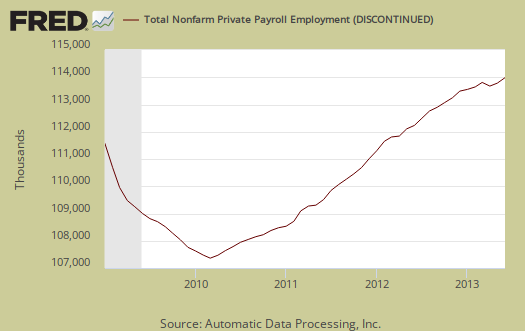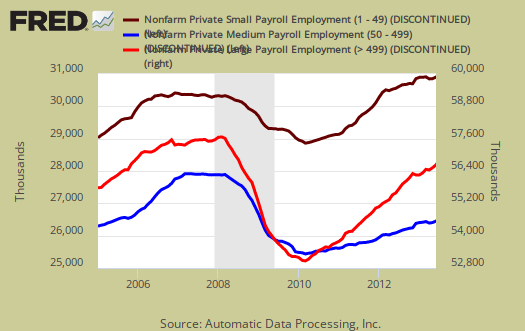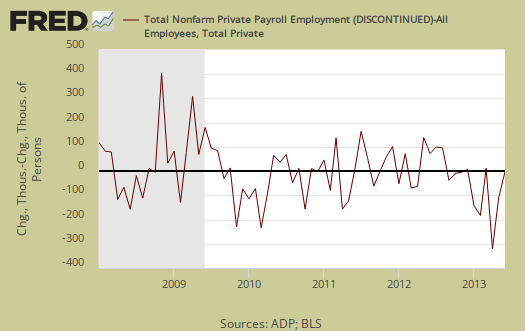ADP's proprietary private payrolls jobs report shows a gain of 188,000 private sector jobs for June 2013. ADP revised May's job figures down by 1,000 to 134 thousand jobs. Overall, June shows some modest improvements in the ADP job figures. This report does not include government, or public jobs.

Jobs gains were in the service sector were 161,000 private sector jobs. The goods sector gained 27,000 jobs, the largest gain in four months. Professional/business services jobs grew by 40,000. Trade/transportation/utilities showed strong growth again with 43,000 jobs. This was the largest growth services sector and the highest growth in trade/transportation and utilities jobs since the start of the year. Financial activities payrolls increased by 13,000, almost double it's preceding pace of job growth for 2013.
Construction work fueled the goods sector job growth with 21,000 jobs added. Manufacturing is still flat with only 1,000 jobs added for the month. Graphed below are the month job gains or losses for the five areas ADP covers, manufacturing (maroon), construction (blue), professional & business (red), trade, transportation & utilities (green) and financial services (orange).

ADP is reporting a general increase in hiring. They make a note that Obamacare is not causing hiring problems. ADP reports payrolls by business size, unlike the official BLS report. Small business, 1 to 49 employees, fueled the private payroll gains by adding 84,000 jobs with establishments having less than 20 employees adding 54,000 of those jobs.
Medium sized business payrolls are defined as 50-499 employees, added they added 55,000 jobs. Large business added 49 thousand to their payrolls. If we take the breakdown further, large businesses with greater than 1,000 workers, added a total of 37,000 jobs. Thing is, we do not know if those are American workers or foreign guest workers on Visas and this time of year brings in more foreign workers due to the H-1B Visa issuances earlier in the year. Other metrics showed large businesses not hiring Americans, in the United States.
Below is the graph of ADP private sector job creation breakdown of large businesses (bright red), median business (blue) and small business (maroon), by the above three levels. For large business jobs, the scale is on the right of the graph. Medium and Small businesses' scale is on the left.

One of the more interesting aspects of the ADP report is the breakdown of the private sector by service producing and goods producing jobs. The service sector are disproportionately lower paying jobs as a whole in comparison to goods producing jobs, even while including the financial, professional and business services sectors are part of services. This month's goods gains might be better news for wages, although the construction industry is notorious for using illegal labor and now has repressed wages. Below is the graph of ADP service sector (maroon, scale left) jobs against their goods production jobs (blue, scale right).

This report, if it matches Friday's official unemployment report, would overall imply overall enough job growth to keep up with population, as this is just the private sector job growth. Government jobs will surely be negative due to sequester and government has been shedding jobs going on years.. The U.S. needs about 115,000 jobs per month, minimum just to keep up with population growth, with the same lousy, artificially low, labor participation rates.
The monthly BLS jobs survey (CES) has a 100,000 payroll jobs overall margin of error. ADP changed their methodology and now claim to match the BLS private payrolls, but only historically, after revisions. The below graph shows shows how many private sector payroll jobs, each month, ADP was off by in comparison to what the BLS reported. This is a monthly graph, not cumulative. As we can see, it's been rare where the two monthly reports get the exact same private payrolls growth numbers. When the below graph bar is negative, that means the BLS reported a larger number of private jobs than ADP did, when the graph bar is positive, it means ADP reported larger private payrolls. Again, compared are private sector jobs which is different from the BLS headline number. The graph is updated with the June BLS jobs report.

Below is the cumulative difference between what the ADP reports as the private nonfarm payroll jobs vs. the BLS (ADP minus BLS). This line shows the divergence, over time in number of nonfarm private payroll jobs reported between the two reports. Previously the difference between ADP and BLS was around 400,000, now we see the cumulative error more in line with the real BLS CES survey margin of error. Here again we see a massive change in the ADP private payrolls methodology and benchmarking. ADP claims their private payrolls cover 24 million jobs with 416 thousand businesses in the U.S. The graph is updated with Friday's BLS private non-farm payrolls data.

The graph below is the monthly change of private jobs as reported by ADP. At the absolutely bare minimum, the United States needs 1.2 million jobs per year, or 100,000 per month, total jobs, including public sector jobs, to keep up with additional new workers in the labor supply caused by population growth with the current terrible labor market conditions assumed.

Regardless of the statistical differences between ADP and the BLS, these payroll figures are none too swell, especially with America's five year, three months employment crisis.
Here is our overview of last month's ADP private sector jobs report overview, only graphs revised. This article goes into the methodology details on the ADP report changes and compares historical data of the two methodologies in graphs.
ADP themselves have really improved the visuals on their website for more perspectives, breakdowns and charts of their statistics.

Recent comments